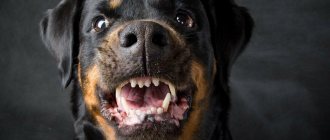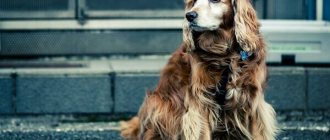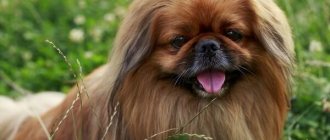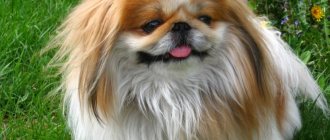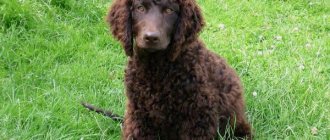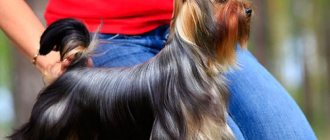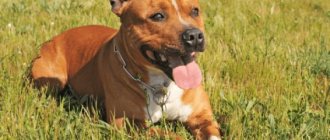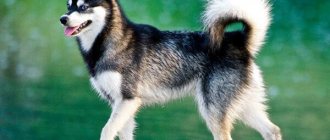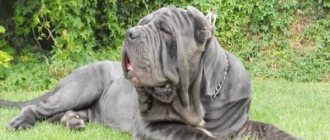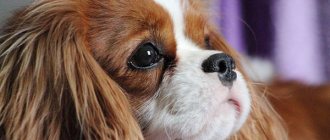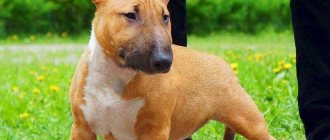The Bull Terrier is a dog breed shrouded in many myths and prejudices.
Some of them are due to the past of these animals, some due to their unusual appearance.
However, not everything you hear about representatives of this breed is true.
And many character traits and characteristics are completely different from common rumors.
Origin history and interesting facts
Bull Terriers are the result of the work of English breeders . After the ban on bullfighting was introduced in 1835, people began to need powerful, strong, fearless and hardy fighting dogs.
Bulldogs were too clumsy, so it was decided to breed new, more compact, agile and agile dogs with the strength and ferocity of bulldogs.
To achieve this, Old English Bulldogs were crossed with Terriers. This is how a new breed appeared - bull and terriers.
Since 1850, D. Hinks began improving the new breed, whose goal was to improve its exterior . To do this, he crossed Bull and Terriers with white Old English Terriers, Bulldogs, Greyhounds, Dalmatians and Scottish Collies.
The breeder presented the result of his work in 1862 at an exhibition in Birmingham - the snow-white dog had not only the best fighting qualities, but also an aristocratic appearance. To avoid confusion, Hinks named the new breed the Bull Terrier.
The new dogs captivated the British and soon became popular all over the world . In 1885, bull terriers were recognized by the American canine organization, and in 1898, a club of fans of this breed was created in the United States.
What to name a bull terrier puppy
Choosing a nickname for bull terriers is a very exciting experience. The dog's name should be easy to pronounce and memorable. Before naming your bull terrier, you can observe the puppy’s character for several days. Sometimes a dog's habits serve as an excellent clue for owners.
The boy can be called:
- Rocky;
- Tucker;
- White;
- Scythian.
For a girl bull terrier, you can choose a soft and melodious nickname. The most suitable names for females:
- Bassey;
- Tina;
- Abby;
- Kerry;
- Chloe.
The English Bull Terrier is a smart, brave and physically strong dog with a unique appearance.
He has a stubborn character and the makings of a born leader. Therefore, a person raising a bull terrier must have limitless patience.
Description and standard
Bull Terriers are energetic, medium-sized dogs with a strong, dry constitution and an almost square body . They move confidently, smoothly and easily.
Representatives of this breed have pronounced sexual demorphism - males are larger, more powerful and more massive than females.
Breed standard:
- the head is ovoid, elongated, the lower jaw is clearly defined;
- the skull is rounded, sloping, the upper part between the ears is flat;
- the nose is large, the nostrils are developed, the earlobe is black;
- lips are dry and fit tightly to the jaws;
- scissor bite;
- the eyes are small, triangular, set obliquely and deeply, the iris is dark brown;
- the ears are small, V-shaped, erect, thin, set close to each other;
- the neck is strong, with well-developed muscles, long, arched, tapering from the shoulders to the head;
- the chest is wide;
- the back is short, strong, wide, straight;
- The loin is wide, slightly convex, muscular;
- tucked stomach;
- the tail is of medium length, thick at the base and slightly tapering towards the end, set low;
- the front legs are strong, even, the length is almost equal to the depth of the chest;
- The hind legs are set parallel, the thighs are well muscled.
The standard does not regulate the weight and height of bull terriers, but these dogs must be as powerful as possible for their size.
Breed standard: main characteristics of the bull terrier
The exact description of the Bull Terrier is given in FCI standard No. 11 (2009). It indicates not only the appearance of the animal, but also its behavior. So the dog should have a strong, muscular body. Males look more masculine, even if they are small in size. Bitches have feminine habits that do not contradict their powerful exterior. The animal is absolutely not aggressive towards people and has a balanced character. He obeys his master, but can be stubborn.
- Head. Long, tapering towards the nose and almost flat between the ears. There are no depressions or bulges on the skull. When viewed from the front, it resembles an egg. The head shape is called “Down-face”. It is unique and not found in any other breed. This is the main feature of the Bull Terrier.
- Muzzle. The nose should be black, with developed nostrils. Narrow eyes are also black or dark brown, slanted, triangular in shape. They are located much closer to the ears than to the nose. The lower jaw is especially powerful. The strong teeth have a scissor bite. The absence of the fourth premolar is allowed, as well as slight deviations in the bite, since it changes throughout the dog’s life.
- Ears. Small, triangular in shape, mobile. Boule can strain them to stand.
- Frame. The powerful body consists of clearly defined muscles. Flat back, wide chest. The belly line curves smoothly upward: from the chest to the back.
- Paws. The limbs are of medium length and are parallel to each other.
- Tail. Wide at the base and tapering towards the end, the tail is short and carried horizontally.
- Wool. Short, stiff and shiny. In winter, a soft undercoat may appear. In the classic version, the bull terrier has a white color, but other options have become recognized: red, tri-colored, murugi. The brindle color is especially prized, while the bluish-gray and liver colors are considered undesirable.
The standard is regularly reviewed and minor changes are made. Based on FCI No. 11, exhibition animals are assessed and individuals are selected for breeding.
Size
The standard does not have exact requirements for the size of a bull terrier. The main condition is that the animal must look massive, harmonious and powerful. On average, an adult dog reaches 55 cm at the withers, but there are representatives that reach a height of 100 cm. The miniature bull has up to 35 cm at the withers.
Weight
The weight of a bull terrier is also not limited. The animal must not be obese. With a standard height of 55 cm, the usual weight is 30 kg. Particularly large representatives of the breed can weigh 55 kg.
Lifespan
Like most other breeds of this size, the Bull lives up to 12-14 years. How long bull terriers live is affected by nutrition, physical activity, and timely visits to the veterinarian.
Intelligence
Some people think that this breed is not very intelligent. However, it is not. The reason for this opinion is a certain stubbornness. An intellectually developed animal evaluates its surroundings and consciously chooses a line of behavior. A willful character can be called one of the manifestations of high intelligence, so it is important to raise a bull correctly.
Bull Terriers
Character traits
There is a firmly entrenched stereotype in society that bull terriers are angry, unbalanced dogs prone to aggressive behavior.
However, despite their fighting past, they are cheerful, affectionate, playful and friendly animals, distinguished by their devotion and ability to find a common language with all family members.
Representatives of this breed are not characterized by aggression towards people . Such behavior has always been considered a serious fault and individuals in which it was observed were rejected.
Bull Terriers are smart and quick-witted dogs . They are highly trainable, but can sometimes be stubborn. Therefore, it is important to raise your pet correctly from an early age.
These dogs do not tolerate loneliness well. Out of boredom and idleness, he begins to look for a way out of his irrepressible energy through damage to property.
They need physical activity, regular active walks, including elements of training, running and other activities that allow them to get rid of energy and stay fit.
Bull Terriers will be excellent pets for active people who love sports and enjoy running . The owner of a bull terrier must be an experienced dog breeder with strong nerves, leadership qualities, patience and perseverance.
Expert opinion
Kozhevin Semyon Kirillovich
Expert dog handler.
Bull Terriers are a serious breed of dog, which, like no other, requires competent education and early socialization. Without training it is impossible to raise a well-mannered and balanced dog. If the owner is irresponsible in raising the pet, bull terriers grow up to be aggressive, extravagant and uncontrollable animals that can pose a danger to others.
Behavior and character of the bull terrier
The dog is ready to obey only a confident and decisive person. When getting a dog of this breed, you need to be prepared to constantly defend your right to leadership.
The Bull was bred for dog fighting, which is why he is endowed with lightning-fast reactions, courage and fortitude. The dog is very stubborn and prone to dominance.
The breed is characterized by natural zoo aggression, and if a person is not sure that he can put the bull in its place, it is better not to keep other pets in the house.
At the same time, bull terriers are smart, playful, curious and loyal to their owner.
Bull Terrier Jaws
Experts say that the force of compression of a bull terrier's jaws is 21-25 atmospheres.
The widespread belief that representatives of this breed have a so-called “death grip” is a myth.
The results of numerous studies have proven that these dogs do not have any special features in the structure of muscles or bones, and the ability to bite small objects and small animals without unclenching their teeth is explained by natural strength.
CAREFULLY!
You can only open the dog's jaw when it has grabbed the victim with a stick, using it as a lever, or a broken ampoule of ammonia - bull terriers cannot stand this smell.
In which countries is the breed prohibited for breeding?
In connection with incidents involving fighting dogs, some countries have introduced an official ban on the breeding and keeping of certain breeds.
Bull Terrier is prohibited:
- in Germany;
- Switzerland;
- Israel;
- Ireland;
- Spain;
- in some states of America.
In the Russian Federation, the Bull Terrier is not prohibited for breeding. But owners of dogs of this breed need to adhere to the existing rules for keeping and walking dogs.
Advantages and disadvantages
In addition to their original, extravagant appearance, bull terriers have the following advantages::
- affectionate, friendly disposition;
- lack of aggression and anger towards people;
- lack of effort;
- strength and endurance;
- intelligence and intelligence;
- ability to learn;
- cleanliness;
- easy care;
- devotion.
Cons of the breed:
- the need for competent education and socialization;
- stubbornness;
- aggressive attitude towards other animals;
- tendency to overheating and sunburn;
- intolerance of loneliness.
In addition, representatives of this breed are not suitable as watchmen and security guards.
Psychological picture
The character of the Bull Terrier is complex. True, pets are far from the fame attributed to them as bloodthirsty killers. But in the wrong hands, a hardy, intelligent bull terrier with a death grip will become a merciless melee weapon.
The dog's behavior depends on its upbringing. With a caring, loving owner, an English Bull Terrier grows up to be open, friendly, and welcoming to strangers. And a nervous, weak, irritable owner will turn into an angry, uncontrollable animal.
Bull Terrier puppies need affection and warmth. Even adult dogs have a hard time withstanding loneliness, but little ones don’t like to be left alone. They need to be surrounded with love and care - then they will grow up obedient and good-natured.
English Bull Terriers have pros and cons. They are loyal, charismatic dogs with a strong character. But the same strong-willed owner can cope with them.
The description of the breed suggests jealousy and stubbornness, which English Bulls inherited from terriers. Dogs are reluctant to share toys and bowls, and compete for the owner’s attention with children and adult family members. Because of these qualities, food, dominance, possessive and play aggression often develops. Any anger is nipped in the bud.
The English Bull Terrier is a one-owner dog. Only one person is involved in his upbringing. If a new family member appears at home, the dog will not obey him either in a month or in 5 years.
Training bull terriers is not easy. Dogs are smart, but capricious and easily distracted. You will have to be patient and put up with repeated repetitions of the simplest commands.
For their fighting past, endurance and strength, bull terriers are called “gladiators”. And light-colored dogs are “white gentlemen” for their refined manners and ability to understand people.
Temperament is highly dependent on genetics. Previously, the breed was bred uncontrollably, which did not have the best effect on its character. Today the situation has changed - sick, psychologically unbalanced animals are not used for mating, and puppies that do not meet the standard are strictly culled.
Only 10% of English Bull Terriers are dangerous to people, and that is due to improper training. It is worth remembering that a puppy is plasticine, and its behavior depends 99% on its owner.
Types and their description
There are 3 types of bull terriers allocated by the FCI:
- English - fast and energetic dogs with a white coat, bred as a result of mating of a bulldog, terrier and Dalmatian;
- Staffordshire - energetic but slow animals that have significant exterior differences from English bulls; the coat can be brindle, black, red and white, brown, red and other colors;
- dwarf - a miniature copy of the English bull terrier with a coat of tri-color, white or yellow-brown color.
All these breeds are independent and only partly related to each other.
How much does a puppy cost?
The cost of a small bull is influenced by the presence of kinship with titled representatives of the breed and the external characteristics of the puppy itself.
In Moscow, the price of a bull terrier is 30-70 thousand rubles.
If you wish, you can purchase a puppy from your own hands. True, the savings often turn out to be dubious, since the risk of buying a mixture of a bull terrier and a husky or a mixture of a dachshund and a bull terrier instead of a purebred dog is too great.
Such mestizos have an interesting appearance, but can be aggressive.
Color variations
In accordance with the breed standard, the skin pigmentation of bull terriers does not matter, and their coat can be:
- white - the most common color in which the coat is solid white, but markings of any color on the head are also acceptable;
- red - a coat of solid red color of any shade without spots or marks;
- black - as a rule, such dogs have small patches of white on their bodies, therefore, despite the predominance of black, the color is classified as bicolor;
- two-color - the wool is painted white and some other color;
- tricolor - coat of white, black and red (brown) colors;
- brindle - red fur with dark stripes, or vice versa, if there are white markings on the face, the color is called brindle-white.
Gray, fawn, blue bull terriers, as well as individuals with a white coat, whose colored spots are not located on the head, are not allowed for breeding.
History of the formation of the breed
As a result, a special breed began to form, which fought tooth and nail, and the fight was lively and bloody. The public rejoiced, the organizers of the fights collected their bloody earnings, and three branches of future Staffordshire bull terriers began to form in the world: small Cradles, plump Warlastons and dry Warsols.
Since for a long time there was no single targeted selection, no one registered the breed as an independent one. Everything changed when a ban on dog fighting was introduced in Europe, rat baiting disappeared, and the need for fighting dogs fell sharply. For personal use and for the purpose of developing a guard and service dog for breeding, dog breeders began to take the Cradley type, which gave modern staffs their appearance as a stocky and broad-chested dog.
But it was not possible to get a guard; the dog is capable of attacking an enemy only on command or because of visible threats; the breed will not patrol the territory and notify strangers by barking that it is inadvisable to enter a home. Thus, modern Staffordshire bull terriers have become active companions for adults who are ready to seriously engage in raising such a difficult breed from a puppy until the end of the animal’s days.
Is he good with children and does he get along with other pets?
Bull Terriers at home get along well with children, becoming excellent nannies for them. These dogs are patient and loyal to children's pranks.
Being cheerful and carefree animals, they quickly find a common language with kids and play with them with pleasure..
At the same time, it is better to get a puppy when there is already a baby in the family - this will help to avoid jealousy on the part of the dog and its attempts to regain the undivided attention of its owners.
IMPORTANT!
At first, communication between the dog and the child must be controlled - the child’s unceremonious behavior can provoke an inadequate reaction from the bull terrier.
Bull Terriers are fighting dogs, the desire to win and be leaders is genetically embedded in them.
Therefore, they cannot stand the competition that other pets create, and the natural instincts of these dogs sooner or later take over. When they see cats, bull terriers lose control and become uncontrollable; dogs see them only as objects of hunting.
Education and training
Bull Terriers are stubborn and headstrong dogs. They will not obey unquestioningly, especially to a weak-willed and weak person. This dog often behaves like a capricious child. It is necessary to show patience, persistence, and consistency in education. But an experienced owner will have a bull terrier that is obedient and affectionate. His high intelligence and quick wit make him an ideal pet. But only if a person can gain authority and immediately show who is boss in the house. Bull Terriers are very smart, independent, and willful. They quickly understand commands, but do not always follow them. To achieve obedience from a dog, you need to take the position of leader from the first day the puppy appears in the house and define the boundaries of what is permitted:
- teach to share toys, allow the owner to take food;
- immediately stop any aggression;
- You should not be allowed to sleep on a bed or walk in the door in front of a person;
- you cannot indulge whims and forgive pranks;
- It is important to reward correct behavior with treats;
- Do not allow cats to be chased or fights with dogs;
- You cannot force a dog to do something, its stubbornness is difficult to overcome, this will only lead to a loss of authority.
Any incorrect behavior must be responded to immediately and strictly, but not with physical punishment. It is important that all family members adhere to the same rules in education. From an early age, a dog needs socialization. She should not react aggressively to changes in the situation or to strangers. A small puppy must be introduced to loud sounds, car noise, and other animals. This will help avoid problems as he gets older. The peculiarity of training this dog is that it has scattered attention. It will take some effort to get your pet interested. Classes should take place in a playful environment and last no more than 10-15 minutes. Training can be time-consuming, but it is necessary, otherwise the Bull Terrier will become uncontrollable. This video will help you learn how to properly raise this dog:
How to properly care
Bull terriers can live in an apartment without any problems, the main thing is the presence of the owner nearby and regular active walks . Moreover, these dogs are very heat-loving, and their short coat makes them unsuitable for outdoor living.
Wool and bathing
Bull Terriers should be brushed no more than 3 times a week using a stiff brush made of natural bristles - this improves blood circulation and gets rid of dust and minor dirt..
During seasonal shedding, you need to comb your pet daily with a special grooming glove.
Representatives of this breed must be bathed as they become dirty, maximum once a quarter, using a special mild shampoo for dogs.
Teeth
To avoid the appearance of plaque and tartar, you need to brush your pet’s teeth once a week with a special brush and toothpaste for dogs.
Eyes
Every morning, wipe with a cotton pad soaked in a special lotion or boiled water.
Claws
As a rule, the nails of adult dogs wear down on their own during walks . If this does not happen, they need to be trimmed every 3-4 weeks with a guillotine nail clipper so as not to touch the blood vessels.
Ears
Clean the inside of your ear weekly with a damp cotton pad. Do not use cotton swabs - any careless movement can lead to hearing loss for your pet.
Caring for puppies
Newborn bull terrier puppies feed on their mother's milk. From three weeks of age, they are gradually introduced to complementary foods. By 1.5-2 months, the puppies are already completely independent and ready to move to a new home.
In order not to expose the little bull to unnecessary stress, at first the dog is fed what the breeder gave. New foods are introduced into the puppy’s diet gradually, observing the reaction of his body.
The number of feedings depends on the age of the dog:
- up to 8 weeks – 6 times a day;
- 2-3 months – 5 times a day;
- 4-6 months – 4 times a day;
- 7-10 months – 3 times a day.
In the future, the bull is transferred to two feedings a day.
Raising a bull terrier puppy begins with accustoming it to a certain routine and rules of behavior in the house. Until the dog has received all its vaccinations, you cannot walk with it.
Therefore, at first the bull is taught to go to the toilet using a diaper or newspaper.
Important! The bull terrier puppy is very curious and tries everything. In order not to endanger the dog, wires and small objects that he might accidentally swallow are hidden from him.
Health and major diseases, life expectancy
On average, bull terriers live 10-15 years.
Representatives of this breed have good immunity and good health, but there are a number of diseases, the predisposition to which is due to genetics:
- deafness;
- acrodermatitis;
- copper toxicosis;
- blepharophimosis;
- hypoplasia of the larynx;
- cleft palate and upper lip;
- dislocation of the elbow and kneecaps;
- hip dysplasia;
- polycystic kidney disease;
- inversion and inversion of the eyelid;
- hypothyroidism;
- bicuspid heart valve dysplasia;
- epilepsy;
- obsessive-compulsive disorder;
- astigmatism;
- aortic stenosis.
As Bull Terriers age, the risk of developing mammary sarcoma and mastocytoma increases..
In addition, these dogs have very delicate skin, which is why in the summer they are at risk of sunburn, and are prone to developing allergic skin reactions - even a mosquito bite can cause itching, rashes and hives.
Protective and guard qualities
Bull Terriers are true guards. They are instantly able to assess the situation and act in case of danger. The dog protects its family and its home. Bitches have a greater predisposition to protection.
Any of the representatives of this specific breed captures facial expressions, movements, intonation with lightning speed and great accuracy; they are excellent psychologists.
Bull Terrier dog - characteristics of the breed, black and white color
Nutritional Features
The Bull Terrier's diet can be based on industrial feed or natural products.
Each owner independently determines what the dog’s nutrition will be; the main thing is not to mix both types of feeding and ensure that the diet is balanced, nutritious and includes all the necessary vitamins, macro- and microelements.
Natural nutrition allows the owner to independently control the quality of food consumed by the pet and diversify the diet as much as possible.
With this type of feeding, the menu must include:
- lean meat;
- chicken or beef by-products;
- boiled sea fish;
- seasonal vegetables and fruits, herbs;
- raw eggs;
- vegetable oils;
- dairy products;
- cereals
You can give your pet hard cheese as a treat.
It is necessary to additionally give the bull terrier a vitamin complex, and up to 18 months - calcium.
Representatives of this breed are prohibited:
- fat meat;
- smoked meats, pickles, marinades;
- sweets, chocolate;
- seasonings;
- River fish;
- spicy and fried foods;
- bakery and pasta products;
- legumes
If the diet is based on ready-made food, it must correspond to the age, physiological state and health of the pet.
You should not skimp on feeding your bull terrier and purchase economy class food - these dogs are suitable for products of at least premium class.
The most suitable brands of food for representatives of this breed are Orijen, AATU, Applaws, Acana, Bozita, Solid, Genesis, GO!, Grandorf.
Content
Adaptation of a puppy after purchase is very fast and allows you to adapt to life in a small apartment or in a private sector. There should be no closed rooms for them, as they escort a person from room to room. The dog should have its place near the room, or better yet, near the owners’ bed, since the bull terrier will not be able to sleep peacefully without checking if there are people there. It is also not worth changing the places of the animal’s personal bowls.
Need for physical activity
The breed is very hardy and needs muscular activity. They must be in constant activity and develop muscles. It is not uncommon for diseases to develop if the dog does not expend enough energy. In this case, the character of the animal changes, the dog becomes angry and uncontrollable.
This will take time for the dog to expend enough energy, you need to facilitate this. If you leave your pet alone at home all the time, he will begin to destroy everything around him out of boredom, which will cause obvious discomfort to people. It is necessary to walk the dog for a long time. At least 3 hours of active time in the fresh air should be spent per day. You can go jogging or cycling together. Just taking your dog to the stadium and working out together will help you become friends.
Appearance care
There are no special requirements for caring for animals. Their fur needs to be brushed regularly to prevent shedding from negatively affecting the cleanliness of the house. It is recommended to wash your pet rarely; after walks, it is enough to wash its paws. You need to clean your ears and wipe your eyes with a soft cloth.
Nutrition
Bull Terriers from two years of age should eat twice a day. The first meal occurs at lunchtime; the diet should include food rich in calcium and fats: boiled meat, cottage cheese and other fermented milk products, vegetables and fruits. The second meal should take place in the evening. This may include raw beef or boiled fish fillets. By-products can also be included in the diet. Hercules is excluded, and other cereals can be given once a week. Tubular bones are not recommended; the dog does not digest them well. Small bull terriers should receive enough vitamins.
It is better to serve food at a high level, attaching the toe to special handrails or stands. The top line of the toes should reach the dog's chest.
Bull Terrier: description and characteristics of the breed
How to choose? Boy or girl?
To have confidence in the purebred and health of the puppy, you should purchase it from a specialized nursery or from trusted breeders . The most suitable age for purchasing a puppy is 2-2.5 months.
The future pet must be carefully examined for pathologies and compliance with the standard.
He must have:
- 12 teeth – 6 at the top and bottom;
- large ovoid head;
- dense bone structure;
- scissor bite;
- small triangular eyes;
- smooth and shiny coat without dandruff;
- clean skin without rashes or irritation.
The puppy should be developed in accordance with its age; lethargy or excessive activity and intrusiveness may indicate developmental abnormalities.
The special structure of the head and ears of Bull Terriers often leads to deafness, so it is important to test the puppy's hearing by clapping your hands and looking at his reaction..
It should be remembered that males of this breed are more assertive, independent and stubborn, while females are much more docile and affectionate. In addition, it is recommended to choose a pet of this breed based on gender: males get along better with women, and females get along better with men.
Undesirable colors
It happens that puppies with a special color are born in a litter, which is not recognized by breed standards. However, dogs with undesirable colors still have names:
- gray bull terrier;
- sand;
- blue;
- dark chestnut.
Today, bull terriers of such colors are quite rare and are usually considered a sign of a non-purebred dog. But despite this, they also have the right to exist.
The color of a bull terrier is, of course, important when buying a puppy. The choice of animal color depends entirely on the preferences of the owner. If the owner is going to exhibit his pet at shows, he should not take a puppy of a non-standard color.
White dogs look less menacing. Their black counterparts are striking in color and create a more intimidating impression. The tricolor coloring will always arouse the genuine interest of others. Which dog to choose - plain or colored - is an entirely individual question.
But in any case, it is necessary to remember that a bull terrier of any color must be properly raised and competently trained. Only in this case will the fighting dog turn into a devoted friend and true protector.
Nurseries in Russia and the CIS
- Constellations of Adomas, Moscow;
- Free Star, Moscow;
- "Nord Line", St. Petersburg;
- Free Jump, Volgograd;
- Castle Thor, Ukraine, Kyiv;
- Blow Century, Ukraine, Bila Tserkva;
- Unkvir Blackstar, Ukraine, Odessa
- “Heliet”, Belarus, Minsk;
- “Tsnyanskaya Hunting”, Belarus, Logoisk district, Tsna village;
- Vale-Vikont, Belarus, Bereza.
Health
Bull Terriers have excellent health. Congenital diseases are extremely rare, but are present:
- deafness;
- tracheal collapse;
- heart diseases;
- discospondyloarthrosis;
- pylorospasm;
- dislocation of the kneecap;
- congenital nephropathy.
Diseases that are acquired:
- dermatitis of various etiologies;
- musculoskeletal injuries;
- chronic kidney disease;
- oncological diseases.
Preventative measures to protect your English Bull Terrier puppy
- To keep your English Bull Terrier puppy completely safe, you first need to minimize his contact with unfamiliar dogs, especially strays. Therefore, you should not let your dog off the leash, as in this case it will become impossible to control its behavior and communication with other dogs. Since a dog can easily become infected with distemper from simply touching the nose of a sick animal. This disease can be transmitted to a dog through sniffing. Your dog can become infected with trichophytosis from contact with the lichen-affected fur of a sick dog. Naturally, it is impossible to completely exclude a dog’s communication with other dogs, since it must be socialized. Therefore, try to find friends with dog lovers who look after their animals. By adhering to this rule, you can eliminate the risk of pathogen transmission by 80%.
- You should walk your dog in places where there are no landfills. Since garbage very often attracts rodents, which in turn are very often carriers of various infections. Gray rats are especially dangerous because they carry such a serious disease as leptospirosis.
- You should not allow your dog to sniff other people's feces, as they are a source of worms.
- Monitor the well-being of your English Bull Terrier. Pay attention to even the most minor changes in his behavior. For example, your dog may appear lethargic, lose his appetite, or have a dry nose. Or you may notice that the dog begins to shed, and this has nothing to do with seasonal shedding. If hair loss becomes excessive, this is the first symptom indicating health problems in your pet. And only you can help him. Therefore, it is important to take the dog to the veterinary clinic in time, where the disease can be overcome for sure. In no case should you ignore the symptoms, since advanced infections are much more difficult to treat, and sometimes even impossible. If you start treating your dog, the disease can lead to his death or he will develop serious complications that will affect his hearing, vision, limbs and much more.
